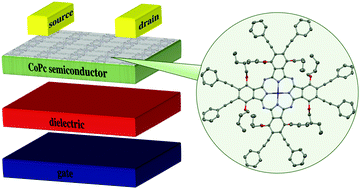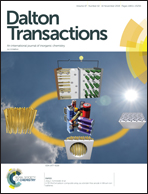π-Extended hexadeca-substituted cobalt phthalocyanine as an active layer for organic field-effect transistors†
Abstract
Due to their flexibility and solution applicability, organic field-effect transistors (OFETs) are considered prominent candidates for application in flexible and low-cost devices. A soluble phthalocyaninato cobalt(II) complex was designed and synthesized based on a hexadeca-substitution pattern by introducing peripheral phenylethynyl groups and non-peripheral n-butoxy groups. The cobalt phthalocyanine derivative was characterized using a wide range of spectroscopic and electrochemical methods, as well as single-crystal X-ray diffraction analysis. An OFET device was fabricated using a spin-coated film of soluble 1,4,8,11,15,18,22,25-octakisbutoxy-2,3,9,10,16,17,23,24-octakis-ethynyl phenyl phthalocyaninato cobalt(II) with a bottom-gate top-contact device configuration. The transfer and output characteristics were investigated to evaluate the charge carrier mobility. The mechanisms of the leakage current through the gate dielectric were also investigated, which revealed that the dominant leakage current mechanism is Fowler–Nordheim tunneling.



 Please wait while we load your content...
Please wait while we load your content...